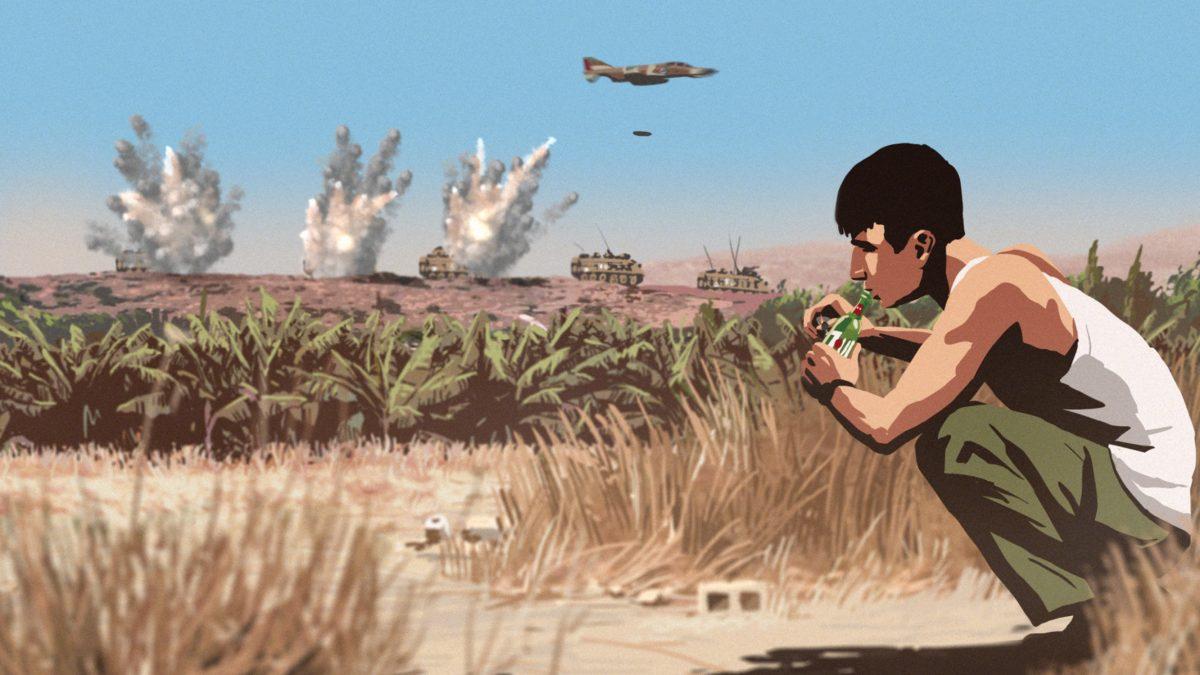A pack of blue dogs tears through city streets and alleyways, barking at something ahead, unseen. These mangy hounds gallop at a frenetic pace, a perfect counterpart to the kinetic industrial electronica playing on the soundtrack while the opening credits roll. The dogs scatter people and upset outdoor furniture in their wake, and still keep running. Finally, one dog stops, then another, and soon enough, the entire pack is standing still at the edge of the sidewalk, looking skywards. They’re peering at a shadowy figure framed by a window on the top floor of a high rise. The figure pulls the window shade down.
So begins Waltz with Bashir, a critically acclaimed film that was Israel’s entry into the Best Foreign Language Film category for the 81st Academy Awards, and one that made many critics year-end best-of lists. The film is based on personal experiences of the director, Ari Folman. The name “Bashir” refers to Lebanese politician Bashir Gemayel. Gemayel was assassinated before the Sabra and Shatila massacre, an event that serves as a focal point for the film.
The film is playing at Cary’s Galaxy Cinema, a theatre well-known for its emphasis on independent and foreign films.
Waltz with Bashir is equal parts meet-and-greet, flashback and dream sequences (also known as “did it or didn’t it happen?”). Many characters are introduced, for varying lengths of screen time, to lend Ari their recollections so that he may piece together his own memory of army time served. Flashback and dream sequences are distinguishable from each other through use of color. Flashbacks are fairly realistic, using desert hues such as olive and tan. Dream sequences utilize very bright and unrealistic colors, making use of caution-tape yellow to illuminate the city during the massacre scene, and various electric blues for the dogs.
The animation style mainly deals in color blocks, adding in certain pertinent details without overwhelming the viewer with information. It is reminiscent of Frank Miller’s color-blocking used in the movie “Sin City” crossed with the storytelling detail of Daniel Clowes. The animation style is neither hyper-realistic nor excessively dream-like, allowing room for both realism and imagination in the course of the story.
The documentary aspect figures prominently throughout the film, with new characters introduced with their full names given in the right-hand corner of the screen, and written in both English and Hebrew characters. (The film’s characters speak in German.) It is also emphasized near the end when a couple of minor characters are interviewed. During these exchanges, Ari is not seen within the frame (as he had been in times previously), but his voice is heard asking the interviewee questions.
A couple of scenes stand out notably from the rest. One such scene concerns Ari’s friend Frankel, who has been assigned a smaller, less powerful gun than he normally uses. After attempting to persuade a fellow soldier to switch guns with him, Frankel boldly strides into the center of the street (in front of the ditch where his comrades reside) and begins shooting. What follows is almost balletic. Frankel’s fancy footwork and graceful turns are similar to pointe work executed by a dancer’s toes.The camera swoops around him like a devoted supporting partner. The use of tinkling piano music (instead of the usual techno) underscores the parallel to dance.
In the last few minutes of the film, the style abruptly switches from animation to real life. The switch occurs after the camera pans over the heads of the mourning women en masse, and when it becomes real footage, the camera focuses on the tear-streaked faces of each one for a few moments. The camera-work adds dimension, layering in shaky, hand-held effects and graininess of the image to lend pathos to the scene at hand.
In short, Waltz with Bashir is a stylized tale of one man’s search for the truth. For him, the truth involves violence and destruction. Scenes are very well realized, some to the point that they haunt the viewer long after having been seen. The documentary style works well given the subject matter, and the story is highly effective.








